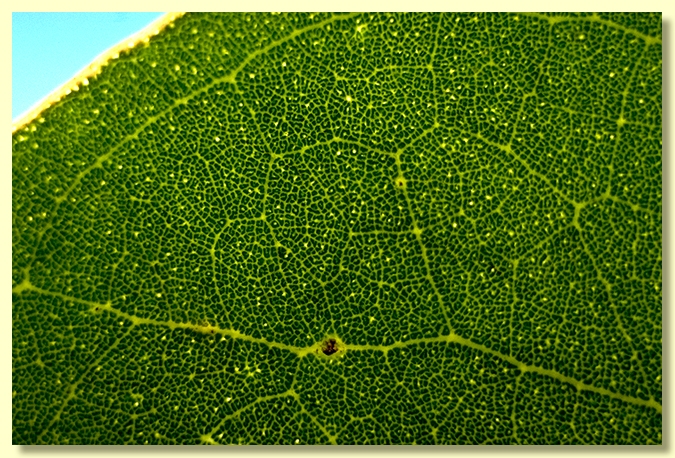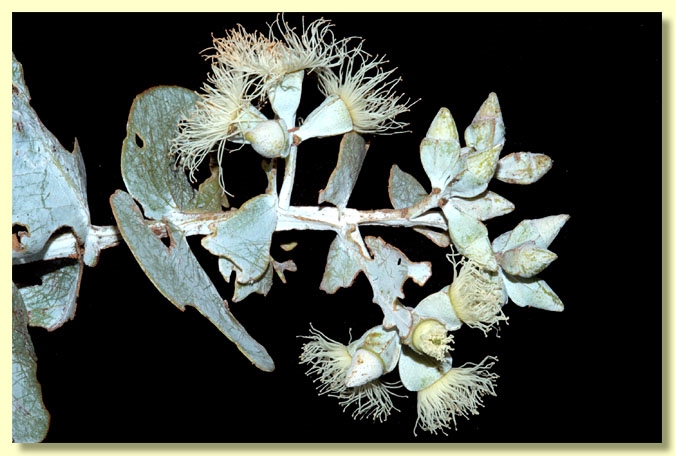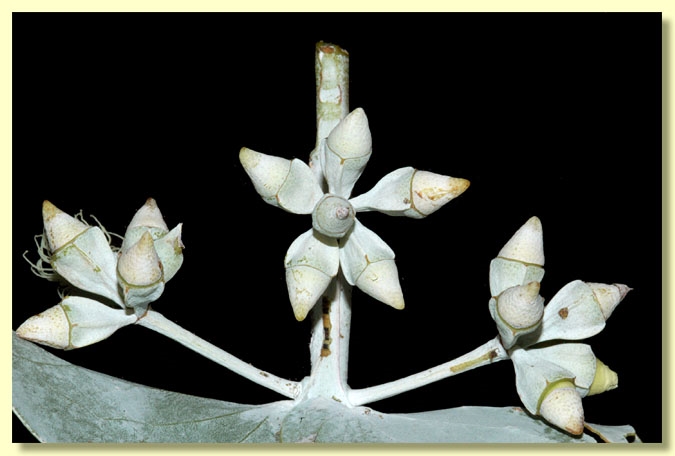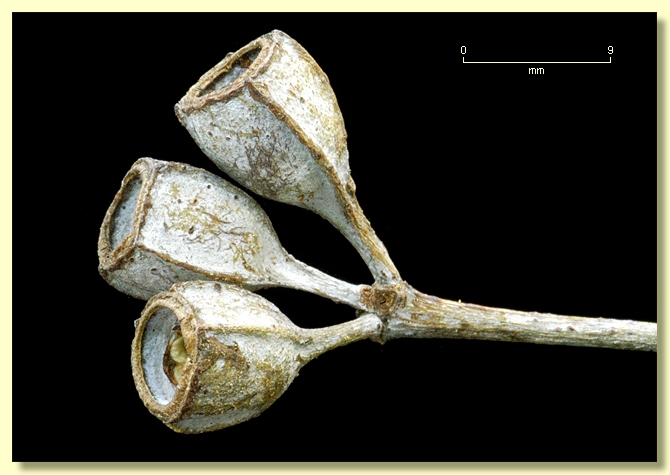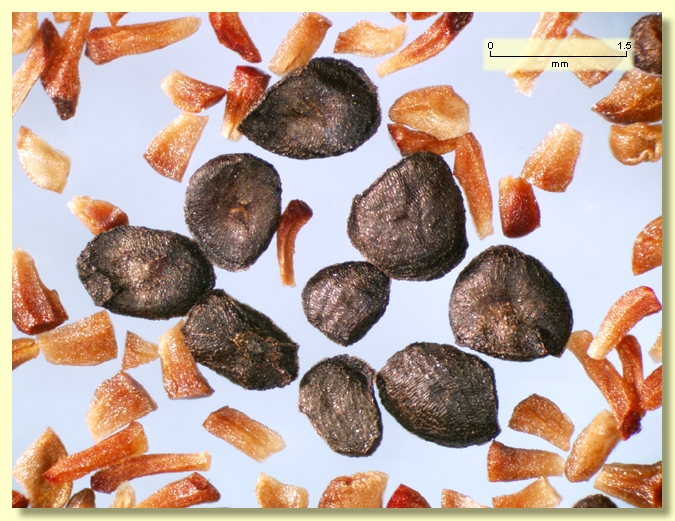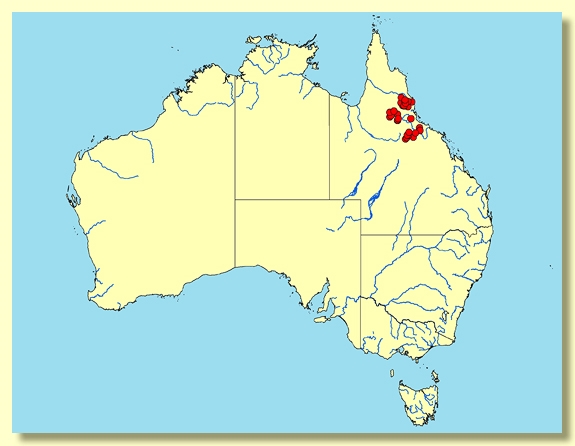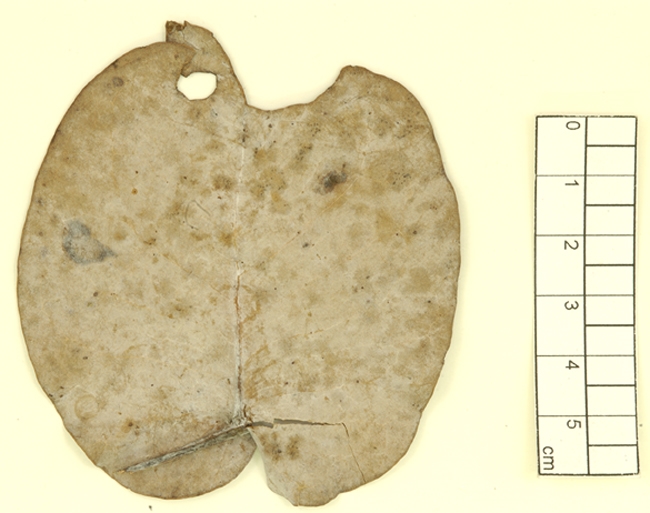Euclid - Online edition
Eucalyptus shirleyi
Eucalyptus | Symphyomyrtus | Adnataria | Apicales | Siderophloiae | Jugatae
Small tree to 7 m tall, often of poor form and mallee-like, occasionally taller to 12 m. Forming a lignotuber.
Ironbark to the smallest branches, dark grey or black; branchlets usually glaucous.
Juvenile growth (coppice or field seedlings to 50 cm): stem square in cross section, glaucous; smooth, juvenile leaves opposite, sessile, orbicular to cordate, 6–13 cm long, 5–10 cm wide, glaucous, apex acute to rounded, base amplexicaul.
Crown usually of juvenile leaves. Crown leaves opposite, sessile, cordate to orbicular to ovate, 5–13(16) cm long, 3–8(10) cm wide, undulate, base amplexicaul, apex variable pointed to rounded to emarginate, concolorous, dull, glaucous, side-veins greater than 45° to midrib, very densely reticulate, intramarginal vein remote from margin and looped, oil glands intersectional or obscure.
Inflorescence terminal compound or axillary single umbels or sometimes compound in subterminal leaf axils, peduncles 1.7–3.7 cm long, buds 7 per umbel, pedicels (0)0.3–0.9 cm long. Mature buds obovoid, 0.8–1 cm long, 0.4–0.6 cm wide, glaucous, sometimes with four longitudinal ribs on the hypanthium, scar present, operculum conical to rounded to slightly beaked, stamens regularly to irregularly flexed, anthers adnate, cuboid, dehiscing by broad lateral pores or slits, style long, stigma blunt to pin-head shaped, locules usually 4, the placentae each with 4 vertical ovule rows. Flowers white.
Fruit ± sessile or on pedicels to 0.8 cm long, cup-shaped to barrel-shaped, the staminophore remaining sometimes to give an urceolate shape, 0.6–1 cm long, 0.5–1 cm wide, may be 4-ribbed/angles basally, glaucous but glaucescence fading with age, disc descending, valves usually 4, near rim level or just below.
Seeds brown, (1)1.5–2 mm long, flattened-ovoid and often pointed at one end, dorsal surface shallowly reticulate, hilum ventral.
Cultivated seedlings (measured at ca node 10): cotyledons reniform; stems square in cross-section; leaves opposite for many nodes (at least 15), sessile or shortly petiolate (petioles to 0.1 cm), ovate, 5–7.3 cm long, 2.6–4 cm wide, base rounded, margin entire, apex pointed, green to grey-green, dull, slightly discolorous.
Flowering has been recorded in January, April and June.
A small ironbark tree or mallee endemic to north and central Queensland from Mt Mulligan south-west through the Herberton – Ravenshoe – Mt Garnet region to the Newcastle Range area near Forsayth, then south through the Lynd – Greenvale – Seaview Range area to the Pentland – Charters Towers – Mingela area, as far south as the Connors Range west of St Lawrence (with possibly two outlying collections, one made from just west of Rockhampton and another from just north-west of Gin Gin). Eucalyptus shirleyi is often found growing on higher elevation sites in very poor soil conditions.
Eucalyptus shirleyi is one of two ironbark species that are very conspicuous in having a crown of glaucous, round to cordate to ovate, opposite, sessile leaves. The other, E. melanophloia, is widely distributed in eastern Queensland and northern New South Wales, north from Dubbo to the Mareeba distict, with outliers around Dajarra in north-west Queensland and another in Central Australia. E. shirleyi usually has larger buds, fruit and juvenile leaves than E. melanophloia. If flowers are present, they can be easily separated on peduncle length. E. shirleyi has a peduncle 1.7–3.7 cm long and E. melanophloia 0.5–1.5 cm long. E. shirleyi often has longitudinal ribs on the buds and fruit, where as E. melanophloia is always rounded. Intermediates between E. shirleyi and E. melanophloia are common in places. E. shirleyi is also known to hybridise with other narrow-leaved ironbarks.
No other ironbark species should be confused with E. shirleyi or E. melanophloia.
Eucalyptus shirleyi : after John Shirley (1849–1922). John Shirley was asked to come Australia from London by the Queensland Department of Education in 1878 and was appointed head-master of the school at Roma. He quickly worked his way through the ranks, becoming an Inspector and then a Senior Inspector, before finally becoming the first principal of the Teacher's Training College in Brisbane in 1914. He held this position until his retirement in 1919.
He had an interest in Botany, particularly the lichens and was able to follow this interest while travelling the state on his inspectorial duties.
During this time he collected and mounted approximately 2500 species of plants.



